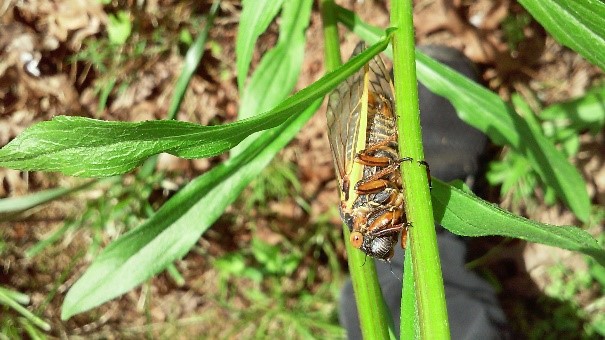The Song of the Cicada
go.ncsu.edu/readext?694576
en Español / em Português
El inglés es el idioma de control de esta página. En la medida en que haya algún conflicto entre la traducción al inglés y la traducción, el inglés prevalece.
Al hacer clic en el enlace de traducción se activa un servicio de traducción gratuito para convertir la página al español. Al igual que con cualquier traducción por Internet, la conversión no es sensible al contexto y puede que no traduzca el texto en su significado original. NC State Extension no garantiza la exactitud del texto traducido. Por favor, tenga en cuenta que algunas aplicaciones y/o servicios pueden no funcionar como se espera cuando se traducen.
Português
Inglês é o idioma de controle desta página. Na medida que haja algum conflito entre o texto original em Inglês e a tradução, o Inglês prevalece.
Ao clicar no link de tradução, um serviço gratuito de tradução será ativado para converter a página para o Português. Como em qualquer tradução pela internet, a conversão não é sensivel ao contexto e pode não ocorrer a tradução para o significado orginal. O serviço de Extensão da Carolina do Norte (NC State Extension) não garante a exatidão do texto traduzido. Por favor, observe que algumas funções ou serviços podem não funcionar como esperado após a tradução.
English
English is the controlling language of this page. To the extent there is any conflict between the English text and the translation, English controls.
Clicking on the translation link activates a free translation service to convert the page to Spanish. As with any Internet translation, the conversion is not context-sensitive and may not translate the text to its original meaning. NC State Extension does not guarantee the accuracy of the translated text. Please note that some applications and/or services may not function as expected when translated.
Collapse ▲Cicadas are unique insects that are known for their song. Male cicadas sing out to find their mate. They do this by flexing their tymbals which are drum-like organs located on their abdomen. Only males can sing, and each cicada species has its own distinctive mating call. While one may think this is useless trivia, it becomes more relevant now that cicadas are visiting in high numbers. If interested visit Cicada Sounds to hear various cicada songs.
There are three types of cicadas categorized by their life-cycle: annual, periodical, and proto-periodical. Annual cicadas emerge every year. Periodical cicadas emerge after a long period of time; more commonly 13-years and 17-years. These cicadas are recognized into Broods that correspond to the series of years in which they will emerge. The proto-periodical cicada may emerge every year with some years being heavier in numbers than others.
This year is the year of the Periodical Cicada Brood IX (9) in parts of North Carolina, Virginia, and West Virginia. And more importantly to know, in Surry County. Some people may refer to them as locust, but locust look a lot more like grasshoppers. Cicadas are a little different. The adults can measure up to 1 ¼ inches long. They are wedge-shaped with black bodies and big red eyes. The veins on their wings are red as well.
The cicadas have already begun to emerge from the ground and will continue until around the end of June. They emerge as nymphs and soon after they will molt into adults. Their trail can be identified by small circular holes in the soil with soil around the hole like a volcano. The nymphs will crawl up on trees, mailboxes, plants, etc. and remain until it molts into the adult. Thin, tan exoskeletons are left behind as the adults develop.
Female adult cicadas will fly around looking for a suitable place to lay her eggs. One cicada can lay up to 500 eggs during her lifetime. Female cicadas will slit small branches and deposit her eggs (usually 10-25 at a time). These slits are visible and may be 1/8 – 3/8 inch in length. Young small trees may be weakened or killed depending on the severity of the damage caused by the cicada. The eggs will hatch in 1.5 – 2.5 months and then the next generation of nymphs moves underground and remains there for 17 years. There are 30 broods of periodical cicadas in the eastern US, with broods I-XVII being the 17-year variety and occurring primarily in the Northeast, and broods XVIII-XXX emerging every 13 years and occurring mainly in the South. However, brood ranges overlap, and in the southern Appalachian region there are both 13- and 17-year cicadas.
Chemical control is generally not recommended for homeowners. During heavy emergence years, it is better to schedule summer pruning after most eggs have been laid but before they have hatched. By waiting until egg-laying is finished, the damage will be spread over the largest area possible, and by cutting and destroying branches before eggs hatch, many nymphs will be prevented from entering the ground and feeding on roots.
Learn Interesting Cicada Trivia
Photo Credits: Extension Master Gardener℠ Volunteers of Surry County: Susan Martin and Intern Cynthia Beane





